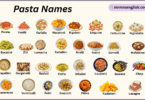- Spinach
- Kale
- Lettuce
- Arugula
- Romaine
- Iceberg
- Mustard greens
- Collard greens
- Swiss chard
- Beet greens
- Turnip greens
- Dandelion greens
- Endive
- Escarole
- Watercress
- Cabbage
- Sesame leaves
- Napa cabbage
- Savoy cabbage
- Bok choy
Leafy Vegetables Names in English and Pictures
- Spinach
Soft, dark green leaves full of iron and vitamins; used in salads and cooking.

- Kale
Curly or flat tough leaves; rich in fiber and known as a “superfood.”

- Lettuce
Light green, crisp leaves often used in burgers and fresh salads.

- Arugula
Peppery-flavored small leaves; commonly used in pizza toppings and leafy salads.

- Romaine
Long, crunchy leaves with a mild taste; popular in Caesar salads.

- Iceberg
Round and pale green leaves with a crisp texture and watery taste.

- Mustard greens
Spicy, slightly bitter leaves; often cooked or added to soups and stir-fries.

- Collard greens
Thick, dark green leaves often boiled or sautéed in southern cooking.

- Swiss chard
Colorful stems with large green leaves; slightly bitter and often sautéed.

- Beet greens
Leaves from beetroot plants; tender when young and great in salads or cooking.

- Turnip greens
Leaves from turnip roots; slightly spicy and packed with nutrients.

- Dandelion greens
Leafy greens from dandelion plants; bitter in taste and used in herbal dishes.

- Endive
Leafy veggie with a crisp bite and slightly bitter taste; used in fancy salads.

- Escarole
Broad-leafed endive with a milder taste; often used in soups and sautés.

- Watercress
Small, round leaves with a peppery taste; usually eaten raw in salads.

- Cabbage
Round leafy vegetable with tightly packed layers; eaten raw or cooked.

- Sesame leaves
Broad, soft leaves with a unique aroma; used in Korean wraps and dishes.

- Napa cabbage
Light green, soft Chinese cabbage; used in stir-fries and kimchi.

- Savoy cabbage
Crinkly, tender leaves with a mild flavor; easier to chew than regular cabbage.

- Bok choy
Chinese leafy green with thick white stems; used in soups and stir-fries.

Types of Leafy Vegetable Name
- Baby spinach
- Baby kale
- Garden cress
- Indian spinach
- Malabar spinach
- Amaranth leaves
- Purslane
- Sorrel
- Radicchio
- Mizuna
- Tatsoi
- Mâche (Lamb’s lettuce)
- Ice plant
- Sweet potato leaves
- Taro leaves
- Pumpkin leaves
- Broccoli leaves
- Cauliflower leaves
- Chaya
- Chrysanthemum greens
Leafy Vegetables Names and their Pictures
- Baby spinach
Young spinach leaves that are soft, tender, and perfect for raw salads.

- Baby kale
Smaller, milder kale leaves that are easier to chew and great in smoothies.

- Garden cress
Tiny, peppery leaves often used fresh in sandwiches or salads for flavor.

- Indian spinach
Green leafy plant common in South Asia; soft, juicy leaves good for curries.

- Malabar spinach
Thick, climbing leaves with a slightly slimy texture; used in Asian cooking.

- Amaranth leaves
Red or green leaves packed with nutrients; cooked like spinach in many cultures.

- Purslane
Small, fleshy leaves with a lemony taste; rich in omega-3 and eaten raw or cooked.

- Sorrel
Sour-tasting green with arrow-shaped leaves; adds tangy flavor to soups and sauces.

- Radicchio
Red-purple leaves with white veins; slightly bitter and often grilled or roasted.

- Mizuna
Japanese leafy green with feathery edges and mild spice; used in salads and stir-fries.

- Tatsoi
Spoon-shaped, dark green leaves with a mild mustard flavor; soft and good raw or cooked.

- Mâche (Lamb’s lettuce)
Soft, nutty-flavored green with small leaves; often eaten fresh in gourmet salads.

- Ice plant
Shiny, juicy leaves that look like they have water drops; eaten raw for a salty crunch.

- Sweet potato leaves
Heart-shaped leaves from the sweet potato plant; tender and great in soups or stir-fries.

- Taro leaves
Large, dark green leaves that must be cooked well to remove bitterness.

- Pumpkin leaves
Soft, hairy leaves from the pumpkin plant; used in stews and African dishes.

- Broccoli leaves
The broad, edible leaves of the broccoli plant; taste similar to kale and full of fiber.

- Cauliflower leaves
Often thrown away, but edible and rich in nutrients; can be sautéed or added to soups.

- Chaya
Also called tree spinach; must be cooked before eating to remove natural toxins.

- Chrysanthemum greens
Strong-scented leafy herb used in Asian hot pots; softens when cooked.

Different Types of Leafy Vegetables Names in English
- Grape leaves
- Mustard spinach
- Rocket leaves
- Horseradish leaves
- Basil leaves
- Celery leaves
- Cilantro leaves
- Dill leaves
- Fennel leaves
- Parsley leaves
- Fenugreek leaves
- Mint leaves
- Curry leaves
- Neem leaves
- Radish greens
- Carrot tops
- Onion greens
- Leek tops
- Garlic chives
- Spring onion greens
Vegetables Names and their Pictures
- Grape leaves
Large, soft leaves from grapevines; often stuffed and cooked in Mediterranean dishes.

- Mustard spinach
A leafy green that looks like spinach but tastes slightly spicy, great for stir-frying.

- Rocket leaves
Also called arugula; thin, peppery leaves used in salads and pizzas.

- Horseradish leaves
Spicy green leaves from the horseradish plant; can be used in cooking or pickling.

- Basil leaves
Fragrant, sweet-smelling leaves used fresh in sauces, especially in Italian cooking.

- Celery leaves
The leafy tops of celery stalks; slightly bitter but great in soups and garnishes.

- Cilantro leaves
Fresh, citrusy leaves widely used in South Asian, Mexican, and Middle Eastern cooking.

- Dill leaves
Fine, feathery green leaves with a mild, sweet taste; used in pickles and seafood dishes.

- Fennel leaves
Soft, thread-like leaves with a licorice-like taste; used for flavor in cooking.

- Parsley leaves
Bright green herb leaves with a fresh taste; used for flavor and garnish.

- Fenugreek leaves
Slightly bitter green leaves used in Indian cooking; known as “methi.”

- Mint leaves
Cool and refreshing green leaves used in drinks, chutneys, and desserts.

- Curry leaves
Aromatic leaves used in South Indian cooking for flavor and digestion.

- Neem leaves
Bitter green leaves known for their health benefits; used in Ayurvedic remedies.

- Radish greens
The leafy tops of radishes; edible and slightly peppery, great in curries.

- Carrot tops
Feathery green leaves on carrots; edible and used in pesto or soups.

- Onion greens
Long, hollow green tops of spring onions; mild in taste, used in salads and cooking.

- Leek tops
Dark green parts of leeks; usually cooked to flavor soups and broths.

- Garlic chives
Flat green leaves with a light garlic taste; used in dumplings and stir-fries.

- Spring onion greens
Tender green stalks from young onions; mild and tasty in eggs, noodles, or salads.

80 Leafy Vegetable Name
- Stinging nettle
- Kohlrabi leaves
- Pea shoots
- Snow pea leaves
- Fiddlehead ferns
- Seaweed (edible varieties)
- Alfalfa leaves
- Corn salad greens
- Chicory greens
- Celosia leaves
- Upland cress
- Spearmint leaves
- Perilla leaves
- Vietnamese coriander
- Water spinach
- Brazilian spinach
- Gynura leaves
- Longevity spinach
- Yarrow leaves
- Shepherd’s purse
Leafy Vegetables Names with their Pictures
- Stinging nettle
A wild green with tiny hairs that sting when raw, but safe and nutritious when cooked.

- Kohlrabi leaves
Edible leaves from the kohlrabi plant; taste like mild kale and can be sautéed.

- Pea shoots
Tender green stems and leaves of young pea plants; slightly sweet and eaten raw or cooked.

- Snow pea leaves
Soft, flat leaves from snow pea plants; lightly sweet and best in stir-fries or soups.

- Fiddlehead ferns
Young curled fern leaves; crunchy, nutty, and cooked like a spring vegetable.

- Seaweed (edible varieties)
Leafy plants from the ocean, rich in minerals; used in sushi, soups, and snacks.

- Alfalfa leaves
Tiny green sprouts eaten raw; mildly nutty and used in salads and sandwiches.

- Corn salad greens
Also known as lamb’s lettuce; soft, rounded leaves with a mild, buttery flavor.

- Chicory greens
Bitter-tasting leaves from the chicory plant; often cooked or mixed with other greens.

- Celosia leaves
Edible leaves from the celosia flower plant; used in African and Asian vegetable dishes.

- Upland cress
A peppery green similar to watercress; often added to salads or sandwiches.

- Spearmint leaves
Fragrant mint leaves with a sweet, cooling taste; used in teas and desserts.

- Perilla leaves
Broad green or purple leaves used in Korean and Japanese cooking; slightly spicy and minty.

- Vietnamese coriander
Spicy, citrus-flavored leaves popular in Southeast Asian soups and fresh rolls.

- Water spinach
Long, hollow stems with soft leaves; widely used in Asian stir-fries and soups.

- Brazilian spinach
Low-growing, crunchy green often eaten raw or cooked in tropical regions.

- Gynura leaves
Fuzzy, green or purple leaves known for their medicinal use and eaten as salad or stir-fry.

- Longevity spinach
A soft leafy green known for health benefits; eaten raw or lightly steamed.

- Yarrow leaves
Feathery herbal leaves used in teas or for medicinal purposes in small amounts.

- Shepherd’s purse
A wild leafy herb with small heart-shaped leaves; often used in traditional remedies or soups.

Learn more helpful articles



























































































Leave a Comment